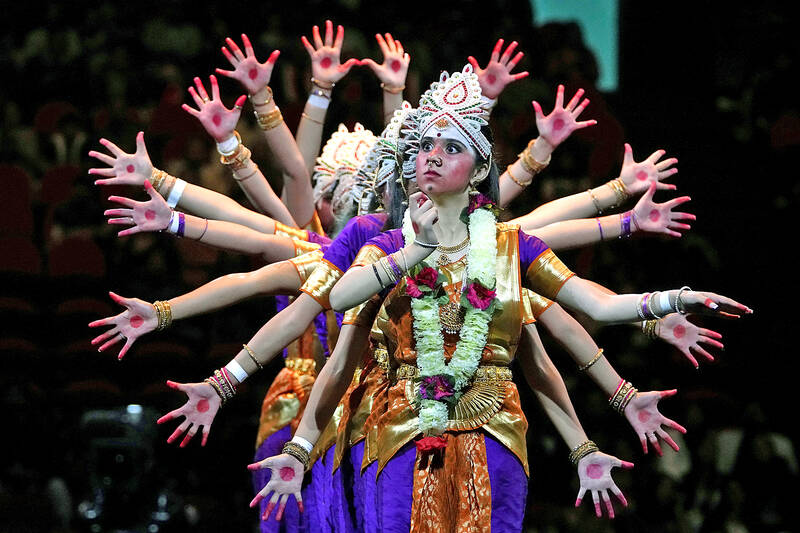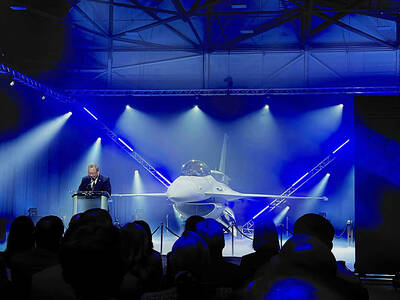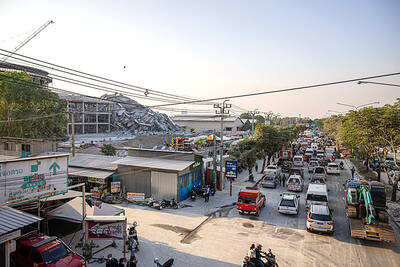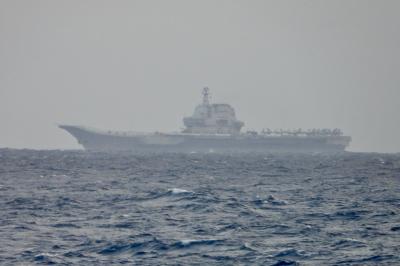Australia yesterday offered Indian Prime Minister Narendra Modi a rock-star welcome, lavishing praise on the Indian leader during a visit heavy on trade and light on criticism.
Modi held a campaign-style rally at a 21,000-capacity Sydney arena, with Australian Prime Minister Anthony Albanese playing emcee.
Lured by the world’s most populous market and a counterweight to China’s growing military, diplomatic and economic clout, the Australian government is layering on the charm.

Photo: AP
To chants of “Modi, Modi, Modi,” Albanese introduced his “dear friend” to a jazzed-up crowd of Indian-Australians, who he praised for making Australia “stronger and more inclusive.”
“The last time I saw someone on the stage here was Bruce Springsteen and he didn’t get the welcome that Prime Minister Modi has got,” Albanese said.
“Prime Minister Modi is the boss,” he said, breaking into a broad smile and boasting the pair had met six times in the past year.
It was an unusually personal show of support for Modi, a nationalist leader who faces re-election next year and has been criticized for democratic backsliding and discrimination against India’s non-Hindus.
Modi reciprocated his host’s praise, offering a long list of interests that bind the two nations — from cricket to curry, yoga to MasterChef.
“The most important foundation of our ties is mutual trust and mutual respect,” he said.
Modi on Monday started his first visit to Australia since 2014, his first year in office.
Behind the flattery and mutual backslapping lie some hardheaded strategy and politics. As Australia struggles with a more assertive China, it is looking for economic and political partners in an increasingly rough-and-tumble neighborhood.
India’s economic performance has been mixed in the past decade, with missteps curbing growth, but hundreds of millions have been lifted out of poverty. It is now the second-fastest growing economy in the G20 and a multitrillion-dollar market, and for both Modi and Albanese, the Indian diaspora offers a rich font of votes and campaign donations, said Ian Hall, an international relations professor at Brisbane’s Griffith University.
“What we saw with this joint appearance in Sydney is an intermingling of Australian and Indian domestic and foreign policy,” Hall said. “Both leaders are looking for funds and support, with the Indian diaspora center stage, and using the bilateral partnership almost as leverage.”
Indian-Australians make up the nation’s fastest-growing and second-largest diaspora, with 673,000 Indian-born citizens in a population of 26 million.
However, Albanese’s warm embrace of Modi has raised questions, too.
Under Modi “the world’s largest democracy” has become less free and more dangerous for his critics, Human Rights Watch’s Elaine Pearson said.
“Modi’s Bharatiya Janata Party-led government has been tightening its grip on civil society, using draconian laws to arrest and intimidate activists, journalists, opposition leaders, academics, peaceful protesters and critics of government policies,” Pearson said.

AIR SUPPORT: The Ministry of National Defense thanked the US for the delivery, adding that it was an indicator of the White House’s commitment to the Taiwan Relations Act Deputy Minister of National Defense Po Horng-huei (柏鴻輝) and Representative to the US Alexander Yui on Friday attended a delivery ceremony for the first of Taiwan’s long-awaited 66 F-16C/D Block 70 jets at a Lockheed Martin Corp factory in Greenville, South Carolina. “We are so proud to be the global home of the F-16 and to support Taiwan’s air defense capabilities,” US Representative William Timmons wrote on X, alongside a photograph of Taiwanese and US officials at the event. The F-16C/D Block 70 jets Taiwan ordered have the same capabilities as aircraft that had been upgraded to F-16Vs. The batch of Lockheed Martin

GRIDLOCK: The National Fire Agency’s Special Search and Rescue team is on standby to travel to the countries to help out with the rescue effort A powerful earthquake rocked Myanmar and neighboring Thailand yesterday, killing at least three people in Bangkok and burying dozens when a high-rise building under construction collapsed. Footage shared on social media from Myanmar’s second-largest city showed widespread destruction, raising fears that many were trapped under the rubble or killed. The magnitude 7.7 earthquake, with an epicenter near Mandalay in Myanmar, struck at midday and was followed by a strong magnitude 6.4 aftershock. The extent of death, injury and destruction — especially in Myanmar, which is embroiled in a civil war and where information is tightly controlled at the best of times —

China's military today said it began joint army, navy and rocket force exercises around Taiwan to "serve as a stern warning and powerful deterrent against Taiwanese independence," calling President William Lai (賴清德) a "parasite." The exercises come after Lai called Beijing a "foreign hostile force" last month. More than 10 Chinese military ships approached close to Taiwan's 24 nautical mile (44.4km) contiguous zone this morning and Taiwan sent its own warships to respond, two senior Taiwanese officials said. Taiwan has not yet detected any live fire by the Chinese military so far, one of the officials said. The drills took place after US Secretary

THUGGISH BEHAVIOR: Encouraging people to report independence supporters is another intimidation tactic that threatens cross-strait peace, the state department said China setting up an online system for reporting “Taiwanese independence” advocates is an “irresponsible and reprehensible” act, a US government spokesperson said on Friday. “China’s call for private individuals to report on alleged ‘persecution or suppression’ by supposed ‘Taiwan independence henchmen and accomplices’ is irresponsible and reprehensible,” an unnamed US Department of State spokesperson told the Central News Agency in an e-mail. The move is part of Beijing’s “intimidation campaign” against Taiwan and its supporters, and is “threatening free speech around the world, destabilizing the Indo-Pacific region, and deliberately eroding the cross-strait status quo,” the spokesperson said. The Chinese Communist Party’s “threats